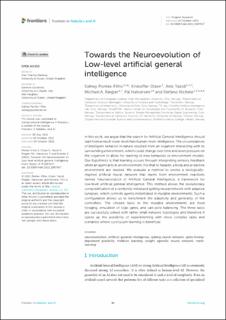| dc.contributor.author | Pontes Filho, Sidney | |
| dc.contributor.author | Olsen, Kristoffer | |
| dc.contributor.author | Yazidi, Anis | |
| dc.contributor.author | Riegler, Michael | |
| dc.contributor.author | Halvorsen, Pål | |
| dc.contributor.author | Nichele, Stefano | |
| dc.date.accessioned | 2023-01-12T12:43:58Z | |
| dc.date.available | 2023-01-12T12:43:58Z | |
| dc.date.created | 2022-11-14T09:34:45Z | |
| dc.date.issued | 2022 | |
| dc.identifier.citation | Frontiers in Robotics and AI. 2022, 9, Artikkel 17547. | en_US |
| dc.identifier.issn | 2296-9144 | |
| dc.identifier.uri | https://hdl.handle.net/11250/3043057 | |
| dc.description.abstract | In this work, we argue that the search for Artificial General Intelligence should start from a much lower level than human-level intelligence. The circumstances of intelligent behavior in nature resulted from an organism interacting with its surrounding environment, which could change over time and exert pressure on the organism to allow for learning of new behaviors or environment models. Our hypothesis is that learning occurs through interpreting sensory feedback when an agent acts in an environment. For that to happen, a body and a reactive environment are needed. We evaluate a method to evolve a biologically-inspired artificial neural network that learns from environment reactions named Neuroevolution of Artificial General Intelligence, a framework for low-level artificial general intelligence. This method allows the evolutionary complexification of a randomly-initialized spiking neural network with adaptive synapses, which controls agents instantiated in mutable environments. Such a configuration allows us to benchmark the adaptivity and generality of the controllers. The chosen tasks in the mutable environments are food foraging, emulation of logic gates, and cart-pole balancing. The three tasks are successfully solved with rather small network topologies and therefore it opens up the possibility of experimenting with more complex tasks and scenarios where curriculum learning is beneficial. | en_US |
| dc.language.iso | eng | en_US |
| dc.publisher | Frontiers Media S.A. | en_US |
| dc.rights | Navngivelse 4.0 Internasjonal | * |
| dc.rights.uri | http://creativecommons.org/licenses/by/4.0/deed.no | * |
| dc.subject | neuroevolution | en_US |
| dc.subject | artificial general intelligence | en_US |
| dc.subject | spiking neural network | en_US |
| dc.subject | spike-timingdependent plasticity | en_US |
| dc.subject | Hebbian learning | en_US |
| dc.subject | weight agnostic neural network | en_US |
| dc.subject | metalearning | en_US |
| dc.title | Towards the Neuroevolution of Low-level artificial general intelligence | en_US |
| dc.type | Peer reviewed | en_US |
| dc.type | Journal article | en_US |
| dc.description.version | publishedVersion | en_US |
| dc.rights.holder | © 2022 Pontes-Filho, Olsen, Yazidi, Riegler, Halvorsen and Nichele. | en_US |
| dc.subject.nsi | VDP::Teknologi: 500 | en_US |
| dc.source.volume | 9 | en_US |
| dc.source.journal | Frontiers in Robotics and AI | en_US |
| dc.identifier.doi | 10.3389/frobt.2022.1007547 | |
| dc.identifier.cristin | 2073211 | |
| dc.source.articlenumber | 17547 | en_US |
| cristin.ispublished | true | |
| cristin.fulltext | original | |
| cristin.qualitycode | 1 | |

